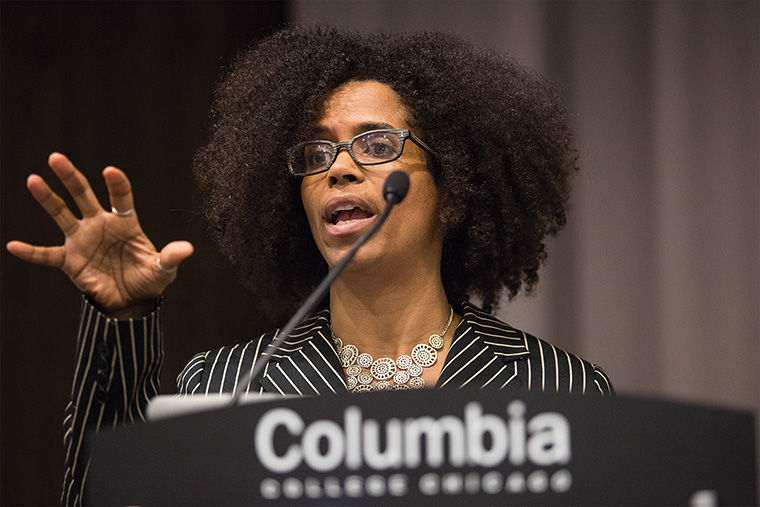Assembly asks to imagine Columbia’s diversity thriving
April 18, 2016
Acknowledging that its work is still in the preliminary stages following the committee’s Jan. 8 formation, the Diversity, Equity and Inclusion Committee discussed its mission at an April 11 assembly at the Stage Two Auditorium in the 618 S. Michigan Ave. Building.
At the forum, which had been postponed from March 7, Onye Ozuzu, chair of the DEI Committee and newly named dean of the School of Fine & Performing Arts, announced that the committee expects to meet with other committees and have a first draft of the college’s diversity statement ready after the semester ends.
Ozuzu said she wanted to use the assembly as an open forum to discuss diversity, equity and inclusion in all aspects of the college.
“We are not a committee that was formed to implement the Strategic Plan,” Ozuzu said. “Our formation is inherently an implementation of the plan. We are a new standing committee appointed by the president that will continue to work with particularly global and structural issues related to diversity, equity and inclusion.”
Ozuzu said the committee has met four times since its formation, and its agenda for the Spring 2016 Semester has included meeting with each Strategic Plan implementation committee to ask questions that will engage each committee in considering how diversity relates to its particular charge.
According to Ozuzu, the committee’s goal is to have a drafted diversity statement by the beginning of the summer so the committee’s members can edit it, discuss it and gather feedback from the college by the beginning of the Fall 2016 Semester.
Amanda Hamrick, a junior interactive arts & media major, Student Government Association executive vice president and co-chair of the College Assembly Committee, said the forum aimed to reveal better approaches to fostering diversity at the college.
“Being here today means you have an interest in diversity either because you simply wish to know more or you have experienced or seen discrimination, and you do not wish to see it at our school, either with the people you work with or the students who attend [Columbia],” Hamrick said.
Ozuzu said she wanted to engage the audience of faculty, staff and students by posing the question of what the college would look like if diversity was thriving. The committee conducted research, which included reading articles about diversity, looking at what is happening in other institutions and conducting interviews with diversity, equity and inclusion officials from institutions nationwide.
“Diversity will[not] be something separate or the responsibility of one committee—our approach to diversity has to be embedded in everything we do [at the college],” Ozuzu said.
After speaking, Ozuzu opened the floor for comments by asking how diversity, equity and inclusion could be infused in each of the Strategic Plan implementation committees, which include the Universal Learning Outcomes, Columbia Core, Integrated First-Year Experience, Registration and New Student Orientation, and Community Engagement committees formed last semester.
In an April 14 emailed statement, Norma Green, a professor in the Communication and Media Innovation Department and member of the ULO Committee, said she, with three other committee members, were assigned to the Diversity & Global Fluency and Critical and Analytical outcomes of the ULO committee.
Green said her team discussed diversity in terms of race, ethnicity, class, education, gender, sexual orientation and religion, among other categories.
“As good as our committee [is]and as hard as we worked to come up with universal [inclusive] outcomes, I believe our committee might have benefited from representation by more people of color and student voices,” Green said.
Green also said the committee discussed emotional health.
Luther Hughes, a senior creative writing major and SGA president, said it is important to have a diverse faculty, but it is also important to teach the members of the college community who do not know about these diversity, equity and inclusion issues through a diverse curricular implementation.
“[Teaching] them how to connect with people that are not of the same community as them, training them to think because it is one [thing] to be competent but another thing to change the [way you] think and what diversity means,” Hughes said. “It is more than having people that are [racially] diverse.”
Teresa Prados-Torreira, an associate professor in the Humanities, History & Social Sciences Department, said to fulfill the goals of the Columbia Core Committee, the college not only needs more diverse faculty but also a more diverse student body.
“Columbia needs many more students of color and students who represent a diverse society because, as we all know, race [and] class intersect, and teachers of color tend to be more sensitive to that connection and understand [students’] context,” Prados said.








